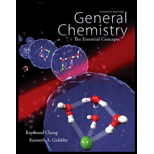
Concept explainers
(a)
Interpretation:
Concept Introduction:
The standard electrode potential of a cell
The relation between Gibbs free energy and cell potential: The amount of energy in a system that can be converted into useful energy is defined as free energy in
Free energy and the cell potential is related by the given equation.
Where,
The amount of electrical charge that is passing through a circuit depends upon the amount and time of the flow of current. The electrical charge is measured in Coulomb.
Where,
Mole is the mass of the substance that is having Avogadro number of particles. The number of moles of a given substance can be calculated by dividing its weight to molecular weight.
(b)
Interpretation:
The capacity of the battery has to be calculated.
Concept Introduction:
The standard electrode potential of a cell
The relation between Gibbs free energy and cell potential: The amount of energy in a system that can be converted into useful energy is defined as free energy in thermodynamics.
Free energy and the cell potential is related by the given equation.
Where,
The amount of electrical charge that is passing through a circuit depends upon the amount and time of the flow of current. The electrical charge is measured in Coulomb.
Where,
Mole is the mass of the substance that is having Avogadro number of particles. The number of moles of a given substance can be calculated by dividing its weight to molecular weight.
(c)
Interpretation:
The capacity of the battery, standard cell potential and free energy change associated with the given cell reaction has to be calculated.
Concept Introduction:
The standard electrode potential of a cell
The relation between Gibbs free energy and cell potential: The amount of energy in a system that can be converted into useful energy is defined as free energy in thermodynamics.
Free energy and the cell potential is related by the given equation.
Where,
The amount of electrical charge that is passing through a circuit depends upon the amount and time of the flow of current. The electrical charge is measured in Coulomb.
Where,
Mole is the mass of the substance that is having Avogadro number of particles. The number of moles of a given substance can be calculated by dividing its weight to molecular weight.
Want to see the full answer?
Check out a sample textbook solution
Chapter 19 Solutions
Package: General Chemistry with Connect 2-year Access Card
 ChemistryChemistryISBN:9781305957404Author:Steven S. Zumdahl, Susan A. Zumdahl, Donald J. DeCostePublisher:Cengage Learning
ChemistryChemistryISBN:9781305957404Author:Steven S. Zumdahl, Susan A. Zumdahl, Donald J. DeCostePublisher:Cengage Learning ChemistryChemistryISBN:9781259911156Author:Raymond Chang Dr., Jason Overby ProfessorPublisher:McGraw-Hill Education
ChemistryChemistryISBN:9781259911156Author:Raymond Chang Dr., Jason Overby ProfessorPublisher:McGraw-Hill Education Principles of Instrumental AnalysisChemistryISBN:9781305577213Author:Douglas A. Skoog, F. James Holler, Stanley R. CrouchPublisher:Cengage Learning
Principles of Instrumental AnalysisChemistryISBN:9781305577213Author:Douglas A. Skoog, F. James Holler, Stanley R. CrouchPublisher:Cengage Learning Organic ChemistryChemistryISBN:9780078021558Author:Janice Gorzynski Smith Dr.Publisher:McGraw-Hill Education
Organic ChemistryChemistryISBN:9780078021558Author:Janice Gorzynski Smith Dr.Publisher:McGraw-Hill Education Chemistry: Principles and ReactionsChemistryISBN:9781305079373Author:William L. Masterton, Cecile N. HurleyPublisher:Cengage Learning
Chemistry: Principles and ReactionsChemistryISBN:9781305079373Author:William L. Masterton, Cecile N. HurleyPublisher:Cengage Learning Elementary Principles of Chemical Processes, Bind...ChemistryISBN:9781118431221Author:Richard M. Felder, Ronald W. Rousseau, Lisa G. BullardPublisher:WILEY
Elementary Principles of Chemical Processes, Bind...ChemistryISBN:9781118431221Author:Richard M. Felder, Ronald W. Rousseau, Lisa G. BullardPublisher:WILEY





